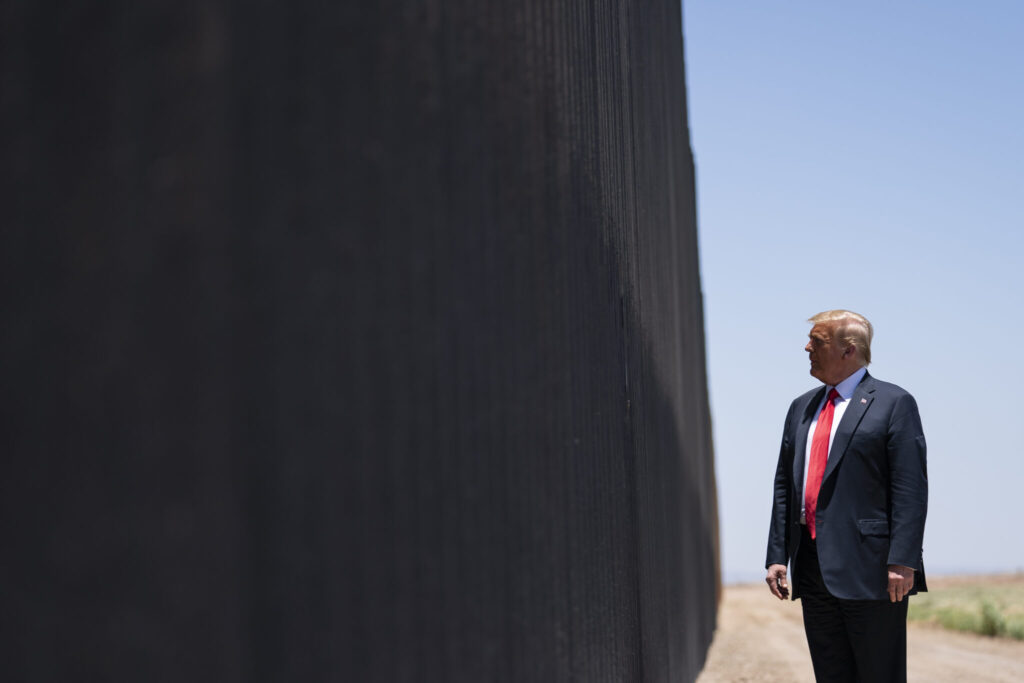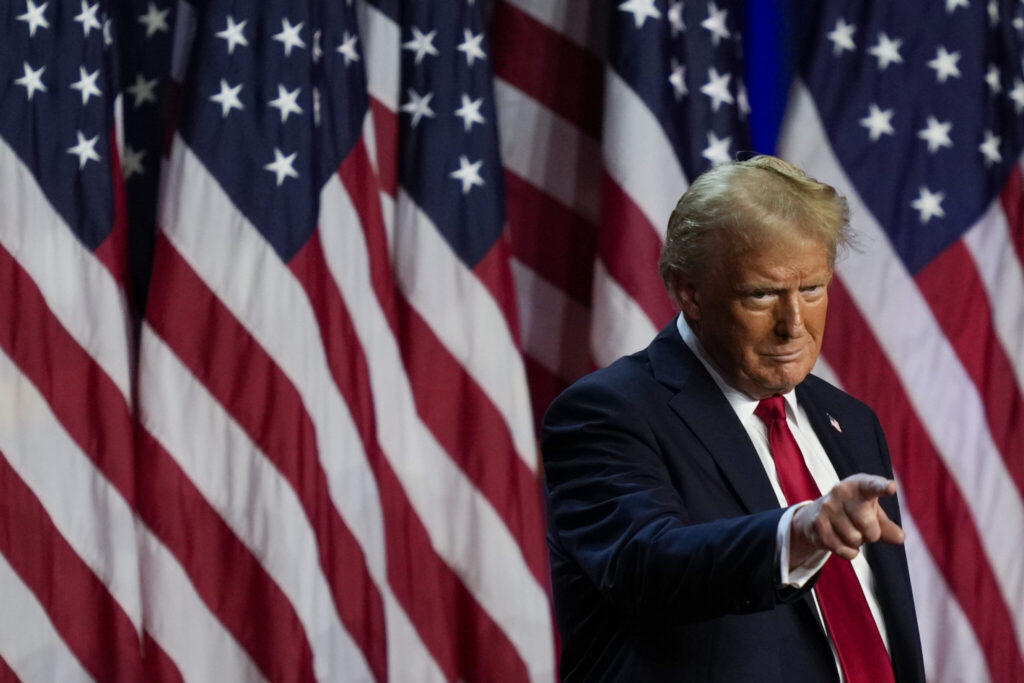Trump second term policy/ immigration reform/ tax cuts/ education overhaul/ trade tariffs/ U.S. foreign policy/ Newslooks/ WASHINGTON/ J. Mansour/ Morning Ediotion/ Donald Trump’s proposed policies for a second term indicate a sweeping approach, blending conservative tax cuts with populist trade measures, reduced civil rights protections, and expanded presidential powers. His agenda covers immigration, economic and trade policies, regulation rollbacks, and isolationist foreign policies. Here’s a look at his major policy proposals and potential impacts on the U.S. and global landscape.

Trump’s 2024 Policy Proposals: Quick Look
- Immigration: Plans for historic mass deportations and reduced legal immigration.
- Abortion: No federal ban proposed, but conservative court influences could change this.
- Tax Policy: Major tax cuts, focusing on corporations and income reclassifications for workers.
- Trade and Tariffs: Significant tariffs proposed on foreign goods, specifically targeting China.
- Federal Bureaucracy and Power: Enhanced presidential powers with significant cuts to civil service protections.
- Education: Plans to eliminate the Department of Education, focusing on conservative values.
- Health and Energy: Repeal of the Affordable Care Act, increased fossil fuel production.
- Workers’ Rights: Reduced union influence, particularly in the auto sector.
- Defense and Foreign Policy: Promises of isolationist policies and reduced NATO engagement.
Trump 2nd-Term: Major Policy Shifts on Economy, Defense & Education
Deep Look
Donald Trump’s return to the White House in 2024 is set to bring substantial policy shifts. His agenda combines traditional conservative measures on taxes and deregulation with an ambitious restructuring of U.S. immigration, trade, and education policies. Trump’s vision emphasizes reduced federal oversight and a return to American-centric, isolationist foreign policies. Here’s a closer examination of his policy proposals.
Immigration: Mass Deportations and Tightened Entry
Trump’s immigration plan signals one of his most aggressive policy areas, aiming to implement what he calls “the largest mass deportation program in history.” Trump’s proposals include deploying the National Guard and empowering local police to target undocumented immigrants. He also plans “ideological screening” for prospective entrants, reviving his 2017 travel ban on several majority-Muslim countries, and eliminating birthright citizenship—a proposal that would likely require a constitutional amendment.
Abortion: Status Quo at the Federal Level, But Court Influence Remains
While Trump claims credit for the 2022 Supreme Court ruling overturning Roe v. Wade, he has notably refrained from pursuing a national abortion ban. Trump’s reluctance has led to the GOP platform excluding such a proposal. However, anti-abortion advocates note that the GOP platform still supports the 14th Amendment argument that fetuses have due process rights, potentially paving a path for federal courts to restrict abortion rights in the future.
Taxes: Corporate Focus with Working-Class Proposals
Trump’s tax policy proposal centers on extending his 2017 tax cuts, focusing on corporations and wealthy individuals by further lowering the corporate income tax rate to 15%. Alongside these cuts, Trump aims to exempt certain types of income, including Social Security and tips, from income taxes—a proposal he argues will support working-class Americans. However, analysts warn that wealthy earners might exploit these exemptions, potentially reclassifying income to benefit from lower tax rates.
Trade and Tariffs: Protectionist Measures
Emphasizing a distrust of global markets, Trump’s trade policy proposes new tariffs ranging from 10% to 20% on imports, with even higher rates suggested for certain goods. Trump’s plan would also reinstate a directive requiring that essential medications be sourced from American companies and would prohibit Chinese investment in critical U.S. infrastructure. His protectionist stance could increase costs for American consumers but aligns with his goal to prioritize domestic manufacturing.
Civil Rights and LGBTQ+ Protections: Scaling Back Federal Programs
Trump aims to roll back civil rights programs, particularly in diversity, equity, and inclusion (DEI) initiatives within government institutions. On LGBTQ+ issues, Trump has repeatedly condemned transgender participation in women’s sports and would end Title IX protections for transgender students, asserting that only two genders should be recognized at birth. These proposals reflect a broader rollback of policies expanded under the Biden administration.
Regulation and Federal Bureaucracy: Expanded Presidential Power
Trump’s second-term vision includes significantly reducing federal regulatory power, particularly in the energy and housing sectors. His plan would open up federal lands to fossil fuel exploration and reduce restrictions on building codes to spur construction. He proposes to make it easier to fire federal employees by placing them outside civil service protections, allowing the executive branch more direct control over federal operations.
Trump also asserts that the president has the authority to control federal spending even when Congress has already approved budgets. By interpreting congressional spending as a cap rather than a requirement, Trump’s view could lead to substantial budgetary disputes with lawmakers. He also floated the idea of increasing presidential influence over the Federal Reserve, potentially upending the traditionally independent monetary policy institution.
Education: Eliminating the Department of Education and Targeting Higher Ed
Trump proposes abolishing the federal Department of Education and ending tenure for teachers, using federal funding to push state schools to align with conservative educational standards. Trump’s college policy includes a new plan to tax or fine universities with substantial endowments, directing those funds to establish a free online “American Academy” designed to offer apolitical college credentials. These measures align with Trump’s pledge to reduce “woke” content in education.
Social Security, Medicare, and Medicaid: Potential Funding Gaps
Trump has vowed to protect Social Security and Medicare, though his tax policy proposals could unintentionally reduce the funding streams for these programs if income types like tips and overtime are excluded from payroll taxes. He has discussed Medicaid sparingly but generally endorsed allowing states greater leeway on federal requirements, suggesting that state-level work requirements for Medicaid could be reintroduced.
Healthcare and the Affordable Care Act: Repeal Without Replacement
Despite repeated promises, Trump has yet to present a replacement for the Affordable Care Act (ACA). His plan to repeal the ACA would remove federally subsidized health insurance coverage, a position that may face pushback from Congress. Trump’s alliance with Robert F. Kennedy Jr., a vocal critic of vaccines, suggests that his administration may revisit public health regulations and policies, particularly around vaccinations and agricultural pesticides.
Climate and Energy: Fossil Fuels and Reduced Environmental Regulation
Dismissing climate change as a “hoax,” Trump’s energy policy is rooted in expanding fossil fuel production and reducing incentives for renewable energy sources. He vows to roll back Biden-era incentives for electric vehicles (EVs) and renewable energy while prioritizing traditional energy infrastructure like roads, bridges, and oil and gas extraction. This fossil fuel-focused strategy would represent a reversal from recent efforts to curb U.S. reliance on carbon-based energy.
Workers’ Rights: Focus on Industry Over Unions
In his outreach to American workers, particularly in manufacturing sectors, Trump has largely focused on criticism of EVs and their potential impact on jobs in the fossil fuel industry. His criticism of union leaders during labor disputes, particularly with the United Auto Workers, indicates that Trump’s policies may make union organizing more difficult.
National Defense and Foreign Policy: Isolationism and “Peace Through Strength”
Trump’s foreign policy is poised to embrace isolationism, particularly regarding NATO and military interventions. He proposes bolstering the military budget and reviving a missile defense shield reminiscent of Cold War-era policies. Trump has pledged to end the conflicts in Ukraine and the Middle East, although he has not provided specifics. His “peace through strength” mantra focuses on maintaining military power while reducing U.S. involvement in global alliances.
Trump’s return to the White House signals a substantial shift from recent U.S. policies, with implications that could reshape America’s role in the world and alter domestic priorities. His sweeping policy proposals reflect a blend of traditional conservative principles with populist and nationalist stances, setting the stage for significant policy battles both domestically and internationally.







